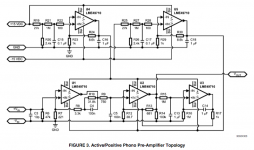Hi all,
Please help me get some things straight on DC servos. I'm fairly new to audio electronics and my experience is mostly limited to the phono preamp described in AN-1651, which was an interesting first foray into this. I want to move onto a new project but I was hoping somebody could explain the design of the servo in that circuit before I get too far ahead of myself.
The schematic in that preamp (see attachment if you're unfamiliar) called for an LME49710 as the servo amp. Why did they use a relatively expensive op-amp for such a "dumb" function? Since the signal is leveled out to near-DC by that .2hz low-pass filter, couldn't I basically substitute a paperweight op-amp to do the job? I'm eyeing a tube of LM358s.
Related question: it would seem obvious that one wouldn't want the servo to have a noisy output, since any noise sent back would soil the "clean" output. So maybe that's one reason to avoid cheap op-amps in that scenario. But why not just run the servo output through a high-pass filter, one that mirrors the low-pass filter on the input?
In the schematic, that looks like what they're doing with C14+R16 (though I'm thrown off by R17, which I suppose might be there to ensure U3 "sees" the right output impedance).
So will any amp do, or should I be choosy about the devices I saddle with the burden of nulling out DC? Any comments most appreciated.
Please help me get some things straight on DC servos. I'm fairly new to audio electronics and my experience is mostly limited to the phono preamp described in AN-1651, which was an interesting first foray into this. I want to move onto a new project but I was hoping somebody could explain the design of the servo in that circuit before I get too far ahead of myself.
The schematic in that preamp (see attachment if you're unfamiliar) called for an LME49710 as the servo amp. Why did they use a relatively expensive op-amp for such a "dumb" function? Since the signal is leveled out to near-DC by that .2hz low-pass filter, couldn't I basically substitute a paperweight op-amp to do the job? I'm eyeing a tube of LM358s.
Related question: it would seem obvious that one wouldn't want the servo to have a noisy output, since any noise sent back would soil the "clean" output. So maybe that's one reason to avoid cheap op-amps in that scenario. But why not just run the servo output through a high-pass filter, one that mirrors the low-pass filter on the input?
In the schematic, that looks like what they're doing with C14+R16 (though I'm thrown off by R17, which I suppose might be there to ensure U3 "sees" the right output impedance).
So will any amp do, or should I be choosy about the devices I saddle with the burden of nulling out DC? Any comments most appreciated.
Attachments
U4 and U5 provide filtered supply voltages to the other amps. (Don't ask me why they need to do this, but I suppose it's for low noise.) U3 is the servo; a correction voltage is applied through R17 to the plus input of U2. This action keeps the average voltage at the output of U2 zero volts.
- Status
- This old topic is closed. If you want to reopen this topic, contact a moderator using the "Report Post" button.
